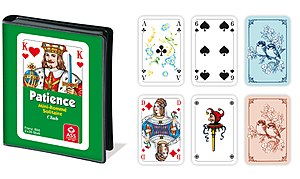
Games of patience, or (card) solitaires as they are usually called in North America, have their own 'language' of specialised terms such as "building down", "packing", "foundations", "talon" and "tableau". Once learnt they are helpful in describing, succinctly and accurately, how the games are played. Patience games are usually for a single player, although a small number have been designed for two and, in rare cases, three or even four players. They are games of skill or chance or a combination of the two. There are three classes of patience grouped by object.[1]
The most frequent object is to arrange the cards either in ascending sequence (e.g. from Ace to King) or descending sequence. Occasionally both forms of sequence are aimed at in the same game. The card forming the starting point of the required sequence is known as the foundation card and the sequence or family is said to be 'built up' on such card. In some cases foundation cards are picked out and placed in position beforehand; in others they are only laid down as they come to hand in course of play. In some instances the cards forming the sequence must be of the same suit as the foundation card; in others suit is disregarded. Some games permit the provisional formation of auxiliary sequences (descending or ascending), i.e. groups of cards in succession but not yet ripe to be played to the families or sequences on the foundation cards. A second object of many patiences is merely to 'pair' cards. The cards thus paired are thrown aside and, if the player is able, under the limitations of the particular game, to throw out all the cards in this way, the game is won. A third object is to throw out or dispose of any two cards which together form a particular number, say eleven or thirteen–the player's success, as before, depending on being able to get rid of all the cards in this manner.[1]
It will be obvious that the endeavour to arrange, pair, or combine the cards of a whole pack is a difficult task, varying in degree according to the rules of the particular game. The player must therefore be prepared for a good many failures even when close to success. Hence why the name 'patience games' has been give to recreations of this description.[1]